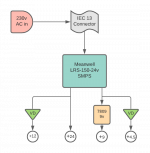Hey Guys,
Long time lurker, first time poster 😉
Im currently looking at building my own clean power amp for my line 6 helix preamp to run though my cabinet. as im working through what i'll do i was wondering if i could have some opinions on the power supply.
I have attached a block diagram and table of my ideas and the 4 voltages and their uses.
Is the best way to achieve this to using a SMPS of 24v regulated straight from the power supply and using a voltage divider to get the 12v bias and then getting the 9v and 4.5v bias by regulating part of the 24v down to 9v and then using another voltage divider? Below is a block diagram of my thoughts.
Would this cause issues and is there a better way to achieve this? Sorry if this has been previously covered.
Long time lurker, first time poster 😉
Im currently looking at building my own clean power amp for my line 6 helix preamp to run though my cabinet. as im working through what i'll do i was wondering if i could have some opinions on the power supply.
I have attached a block diagram and table of my ideas and the 4 voltages and their uses.
Is the best way to achieve this to using a SMPS of 24v regulated straight from the power supply and using a voltage divider to get the 12v bias and then getting the 9v and 4.5v bias by regulating part of the 24v down to 9v and then using another voltage divider? Below is a block diagram of my thoughts.
Would this cause issues and is there a better way to achieve this? Sorry if this has been previously covered.
Attachments
You may want some filtering between the supplies - the digital side will create a clock noise back up the supply.
Also what currents are needed?
Also what currents are needed?
Hi Nick,
Thanks for the reply. I'd definitely have filtering caps for the 9v Regulator. I'm yet to do the sums but I'm looking to have about 10w output on the LM1875 @ 8ohm. So the 24+v supply would be for a few amps max, but the rest would be drawing small amounts. Would you recommend filter caps on each Voltage change?
Thanks for the reply. I'd definitely have filtering caps for the 9v Regulator. I'm yet to do the sums but I'm looking to have about 10w output on the LM1875 @ 8ohm. So the 24+v supply would be for a few amps max, but the rest would be drawing small amounts. Would you recommend filter caps on each Voltage change?
Voltage dividers are wasteful, and have a high internal resistance (there is a tradeoff between the quiescent power and the resistance).
For low to medium-power loads, monolithic regulators are optimal, and for very low power (say <10~20mA), shunt/zener regulators are OK.
For low to medium-power loads, monolithic regulators are optimal, and for very low power (say <10~20mA), shunt/zener regulators are OK.
Thank you 😊 I'm just accustomed to seeing biasing done with dividers so I was stuck in that thinking. Would using multiple lm317s or an ldo be more effective? I
It depends on the currents drawn: for >100mA, a 317 or similar would be OK, but there are lots of lower-power regulators suitable if the current is between 5mA and 100mA.
For really low currents, a zener or TL431-based regulator is fine.
And if no current at all is drawn, a voltage divider can be used to establish a fixed bias voltage
For really low currents, a zener or TL431-based regulator is fine.
And if no current at all is drawn, a voltage divider can be used to establish a fixed bias voltage
Thank you for the information. This might be the worst thing you get asked this year but there's a grey area here in Australia about wiring mains and stepdown transformers. One loophole is a lighting transformer like this. If the 24vac is the rectified, filtered and regulated would there be any reason for this to not be suitable?
Thanks! Out of curiosity, if this transformer had its ac output rectified to dc, regulated and then filtered for noise is there any reason it wouldn't work? 240V to 24VAC 150VA Lighting Transformer | Jaycar Electronics
You have to be careful with lighting transformers: nowadays, they are very often electronic types, meaning they are in fact simplified SMPS's, and they do not like anything else than a light-bulb as a load.
This one looks like a real, iron and copper one, but there is no way to be sure: there are no detailed specifications, and even the weight is not mentioned (weight provides good clues for determining the technology of a transformer).
Note that it is not a safety issue: all types are double insulated, low-voltage safety types, but an electronic transformer may simply not work.
Note that if you rectify/filter the output of a conventional 24V transformer, you will get 34~35VDC when loaded, and significantly more under low or light load conditions
This one looks like a real, iron and copper one, but there is no way to be sure: there are no detailed specifications, and even the weight is not mentioned (weight provides good clues for determining the technology of a transformer).
Note that it is not a safety issue: all types are double insulated, low-voltage safety types, but an electronic transformer may simply not work.
Note that if you rectify/filter the output of a conventional 24V transformer, you will get 34~35VDC when loaded, and significantly more under low or light load conditions
- Home
- Amplifiers
- Power Supplies
- Multiple Supply Voltage Topology

